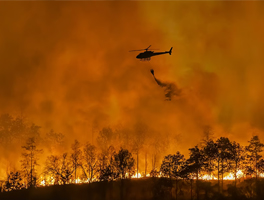 |
Dear readers,
Welcome to the Climate Weekly newsletter by the Centre for Science and Environment’s Climate Change programme and Down to Earth.
In January 2025, the India Meteorological Department (IMD) declared 2024 as the country’s hottest year on record, reporting a mean surface temperature anomaly of +0.65°C above the long-term average. However, a closer examination by Rajit Sengupta and Kiran Pandey reveals an altering of the benchmark against which warming is measured—the Long Period Average (LPA)—in IMD’s reporting. This is a serious concern, as the actual warming may have crossed 1°C, raising serious concerns about the implications for extreme weather events and biodiversity loss.
The LPA represents a 30-year temperature average and is central to assessing climate trends. The IMD has shifted the baseline by a decade with each revision, effectively making the anomaly appear smaller than it is. Until 2010, the IMD used the ‘1961–1990’ average, this was shifted ahead by a decade in 2016 and then again in 2019. Lastly, in 2024, the IMD shifted to the ‘1991–2020’ average. This has major implications, as it means comparing current temperatures with a hotter average. Applying corrections to 2024’s anomaly of +0.65°C above the ‘1991–2020’ average reveals that the actual deviation from the ‘1961–1990’ LPA could be as high as +1.19°C.
A new study on the variability of Indian summer monsoon has highlighted the threat of climate impacts on the Bay of Bengal’s marine life and food security. According to the findings, extremely weak or strong summer monsoon could reduce marine biodiversity in the Bay of Bengal, risking the food security of millions of people in the region. Over centuries, both extreme strong or weak monsoon have caused a 50 per cent drop in food availability at the surface. Despite covering less than 1 per cent of the global ocean, the Bay of Bengal provides nearly 8 per cent of the world’s fish production.
Finally, CSE is launching its public dashboard on India’s Voluntary Carbon Market (VCM) to fill crucial gaps in transparency and understanding for carbon offset projects across India. The dashboard covers state-level data on offset projects, sectors covered, credits issued and who is buying them—making it an excellent resource to find out about, monitor, and track India’s VCM. On May 13, Avantika Goswami and Trishant Dev of CSE’s Climate Change programme will provide a masterclass on how to effectively navigate and utilise the dashboard. For registrations, click here.
|
|
 |
| |
 |
|
| |
 |
 |
| |
By - Upamanyu Das
Climate Change, CSE
|
| |
|
 |
|
|
| |
 |
|
| |
| EXTREME WEATHER TRACKER |
| |
Is India understating its warming trend by changing baselines?, 01 May 2025
|
 |
 |
|
|
| |
 |
|
| |
 |
 |
Climate change narrowing gap between fire seasons in eastern Australia and western North America, 30 April 2025
|
|
|
| |
|
|
| |
|
|
| |
 |
|
| |
|
|
| |
|
|
| |
|
|
| |
 |
|
| |
|
|
| |
 |
|
| |
CLIMATE NEWS | SCIENCE| IMPACTS| POLITICS |
|
| |
 |
|
| |
|
|
| |
 |
|
| |
|
|
| |
 |
|
| |
|
|
| |
 |
|
| |
|
|
| |
 |
|
| |
|
|
| |
 |
|
| |
|
|
| |
 |
|
| |
|
|
| |
 |
|
| |
|
|
| |
 |
|
| |
|
|
| |
 |
|
| |
|
|
| |
 |
|
| |
|
|
| |
|
|
| |
|
|
| |
|
|